Page 356 of 426
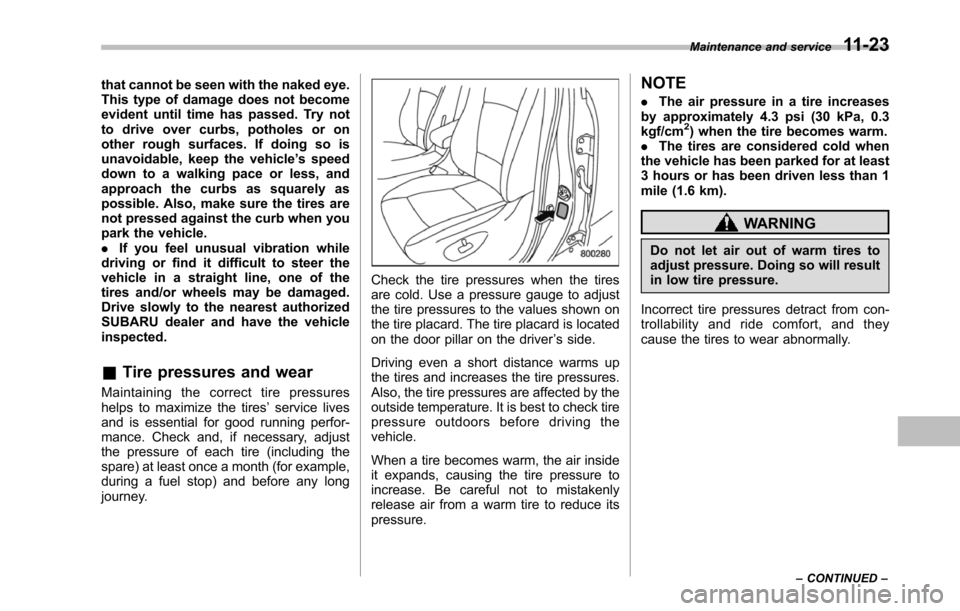
that cannot be seen with the naked eye.This type of damage does not becomeevident until time has passed. Try notto drive over curbs, potholes or onother rough surfaces. If doing so isunavoidable, keep the vehicle’s speeddown to a walking pace or less, andapproach the curbs as squarely aspossible. Also, make sure the tires arenot pressed against the curb when youpark the vehicle..If you feel unusual vibration whiledriving or find it difficult to steer thevehicle in a straight line, one of thetires and/or wheels may be damaged.Drive slowly to the nearest authorizedSUBARU dealer and have the vehicleinspected.
&Tire pressures and wear
Maintaining the correct tire pressureshelps to maximize the tires’service livesand is essential for good running perfor-mance. Check and, if necessary, adjustthe pressure of each tire (including thespare) at least once a month (for example,during a fuel stop) and before any longjourney.
Check the tire pressures when the tiresare cold. Use a pressure gauge to adjustthe tirepressures to the values shown onthe tire placard. The tire placard is locatedon the door pillar on the driver’s side.
Driving even a short distance warms upthe tires and increases the tire pressures.Also, the tire pressures are affected by theoutside temperature. It is best to check tirepressure outdoors before driving thevehicle.
When a tire becomes warm, the air insideit expands, causing the tire pressure toincrease. Be careful not to mistakenlyreleaseair from a warm tire to reduce itspressure.
NOTE
.The air pressure in a tire increasesby approximately 4.3 psi (30 kPa, 0.3kgf/cm2) when the tire becomes warm..The tires are considered cold whenthe vehicle has been parked for at least3 hours or has been driven less than 1mile (1.6 km).
WARNING
Do not let air out of warm tires toadjust pressure. Doing so will resultin low tire pressure.
Incorrect tire pressures detract from con-trollability and ride comfort, and theycause the tires to wear abnormally.
Maintenance and service11-23
–CONTINUED–
Page 357 of 426
11-24Maintenance and service
.Correct tire pressure(tread wornevenly)
Roadholding is good, and steering isresponsive.Rolling resistance is low, sofuel consumption is also lower.
.Abnormally low tire pressure(treadworn at shoulders)
Rolling resistance is high, so fuel con-sumption is also higher.
.Abnormally high tire pressure(treadworn in center)
Ride comfort is poor. Also, the tiremagnifies the effects of road surfacebumps and dips, possibly resulting invehicle damage.
WARNING
Driving at high speeds with exces-sively low tire pressures can causethe tires to deform severely and torapidly become hot. A sharp in-crease in temperature could causetread separation, and destruction ofthe tires. The resulting loss ofvehicle control could lead to anaccident.
Page 359 of 426
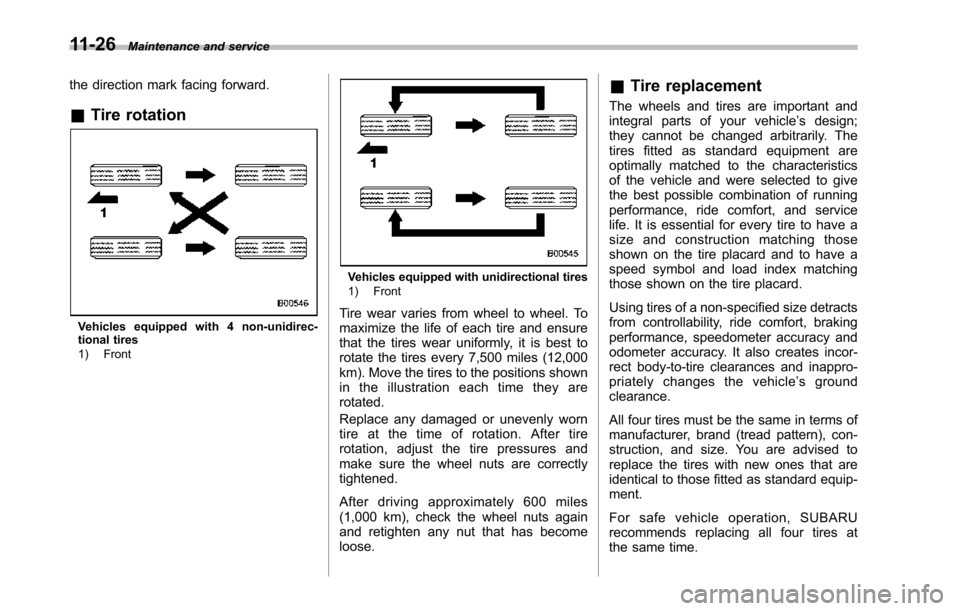
11-26Maintenance and service
the direction mark facing forward.
&Tire rotation
Vehicles equipped with 4 non-unidirec-tional tires1) Front
Vehicles equipped with unidirectional tires1) Front
Tire wear varies from wheel to wheel. Tomaximize the life of each tire and ensurethat the tires wear uniformly, it is best torotate the tires every 7,500 miles (12,000km). Move the tires to the positions shownin the illustration each time they arerotated.
Replace any damaged or unevenly worntire at the time of rotation. After tirerotation, adjust the tire pressures andmake sure the wheel nuts are correctlytightened.
After driving approximately 600 miles(1,000 km), check the wheel nuts againand retighten any nut that has becomeloose.
&Tire replacement
The wheels and tires are important andintegral parts of your vehicle’s design;they cannot be changed arbitrarily. Thetires fitted as standard equipment areoptimally matched to the characteristicsof the vehicle and were selected to givethe best possible combination of runningperformance, ride comfort, and servicelife. It is essential for every tire to have asize and construction matching thoseshown on the tire placard and to have aspeed symbol and load index matchingthose shown on the tire placard.
Usingtires of a non-specified size detractsfrom controllability, ride comfort, brakingperformance, speedometer accuracy andodometer accuracy. It also creates incor-rect body-to-tire clearances and inappro-priately changes the vehicle’sgroundclearance.
All four tires must be the same in terms ofmanufacturer, brand (tread pattern), con-struction, and size. You are advised toreplace the tires with new ones that areidentical to those fitted as standard equip-ment.
For safe vehicle operation, SUBARUrecommends replacing all four tires atthe same time.
Page 385 of 426
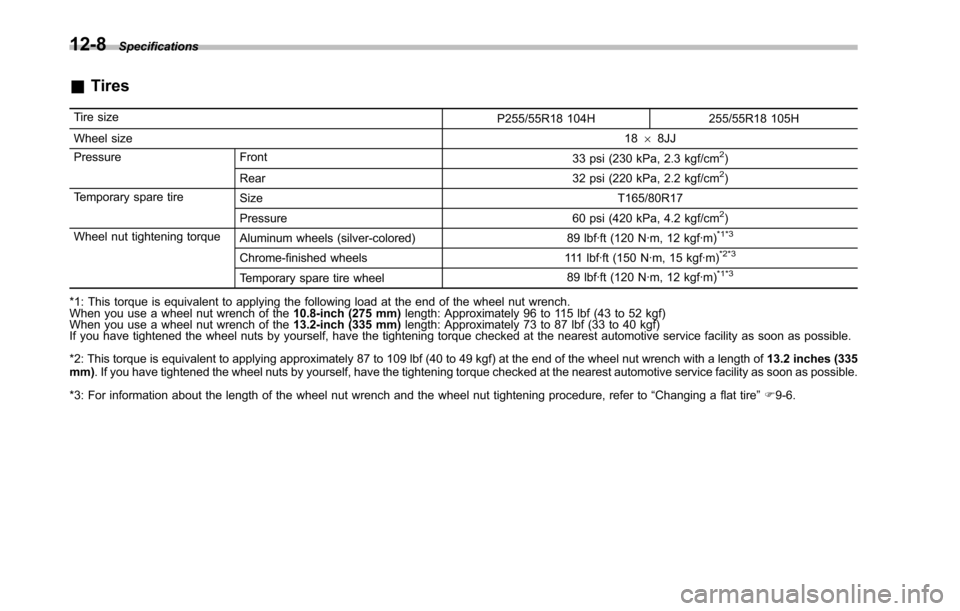
12-8Specifications
&Tires
Tire sizeP255/55R18 104H 255/55R18 105H
Wheel size1868JJ
Pressure Front33 psi (230 kPa, 2.3 kgf/cm2)
Rear 32 psi (220 kPa, 2.2 kgf/cm2)
Temporary spare tireSize T165/80R17
Pressure 60 psi (420 kPa, 4.2 kgf/cm2)
Wheel nut tightening torqueAluminum wheels (silver-colored) 89 lbf·ft (120 N·m, 12 kgf·m)*1*3
Chrome-finished wheels 111 lbf·ft (150 N·m, 15 kgf·m)*2*3
Temporary spare tire wheel89 lbf·ft (120 N·m, 12 kgf·m)*1*3
*1: This torque is equivalent to applying the following load at the end of the wheel nut wrench.When you use a wheel nut wrench of the10.8-inch (275 mm)length: Approximately 96 to 115 lbf (43 to 52 kgf)When you use a wheel nut wrench of the13.2-inch (335 mm)length: Approximately 73 to 87 lbf (33 to 40 kgf)If you have tightened the wheel nuts by yourself, have the tightening torque checked at the nearest automotive service facility as soon as possible.
*2: This torque is equivalent to applying approximately 87 to 109 lbf (40 to 49 kgf) at the end of the wheel nut wrench with a length of13.2 inches (335mm). If you have tightened the wheel nuts by yourself, have the tightening torque checked at the nearest automotive service facility as soon as possible.
*3: For informationabout the length of the wheelnut wrenchand the wheel nut tightening procedure, refer to“Changinga flat tire”F9-6.
Page 392 of 426
Vehicle identification1) Vehicle identification number2) Certification and bar code label3) Tire inflation pressure label4) Vehicle identification number plate5) Model number label6) Emission control label7) Fuel label8) Air conditioner label
Specifications12-15
Page 394 of 426

For U.S.A............................................................ 13-2
Tire information.................................................. 13-2Tire labeling....................................................... 13-2Recommended tire inflation pressure.................. 13-4Glossary of tire terminology............................... 13-5Tire care–maintenance and safety practices...... 13-9Vehicle load limit–how to determine................ 13-10Determining compatibility of tire and vehicleload capacities............................................... 13-13
Adverse safety consequences of overloadingon handling and stopping and on tires........... 13-13Steps for Determining Correct Load Limit......... 13-13
Uniform tire quality grading standards.......... 13-14Treadwear....................................................... 13-14Traction AA, A, B, C......................................... 13-14Temperature A, B, C......................................... 13-15
Reporting safety defects (U.S.A.)................... 13-15
Consumer information and Reporting safety defects
13
Page 396 of 426
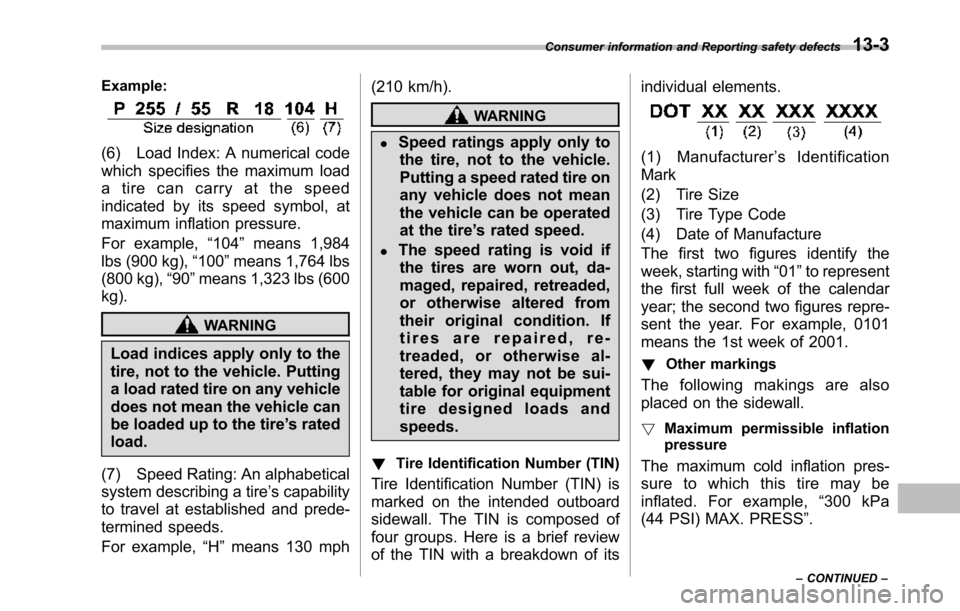
Example:
(6) Load Index: A numerical code
which specifies the maximum load
atirecancarryatthespeed
indicated by its speed symbol, at
maximum inflation pressure.
For example,“104”means 1,984
lbs (900 kg),“100”means 1,764 lbs
(800 kg),“90”means 1,323 lbs (600
kg).
WARNING
Load indices apply only to the
tire, not to the vehicle. Putting
a load rated tire on any vehicle
does not mean the vehicle can
be loaded up to the tire’s rated
load.
(7) Speed Rating: An alphabetical
system describing a tire’s capability
to travel at established and prede-
termined speeds.
For example,“H”means 130 mph
(210 km/h).
WARNING
.Speed ratings apply only to
the tire, not to the vehicle.
Putting a speed rated tire on
any vehicle does not mean
the vehicle can be operated
at the tire’s rated speed.
.The speed rating is void if
the tires are worn out, da-
maged, repaired, retreaded,
or otherwise altered from
their original condition. If
tires are repaired, re-
treaded, or otherwise al-
tered, they may not be sui-
table for original equipment
tire designed loads and
speeds.
!Tire Identification Number (TIN)
Tire Identification Number (TIN) is
marked on the intended outboard
sidewall. The TIN is composed of
four groups. Here is a brief review
of the TIN with a breakdown of its
individual elements.
(1) Manufacturer’sIdentification
Mark
(2) Tire Size
(3) Tire Type Code
(4) Date of Manufacture
The first two figures identify the
week, starting with“01”to represent
the first full week of the calendar
year; the second two figures repre-
sent the year. For example, 0101
means the 1st week of 2001.
!Other markings
The following makings are also
placed on the sidewall.
!Maximum permissible inflation
pressure
The maximum cold inflation pres-
sure to which this tire may be
inflated. For example,“300 kPa
(44 PSI) MAX. PRESS”.
Consumer information and Reporting safety defects13-3
–CONTINUED–
Page 397 of 426
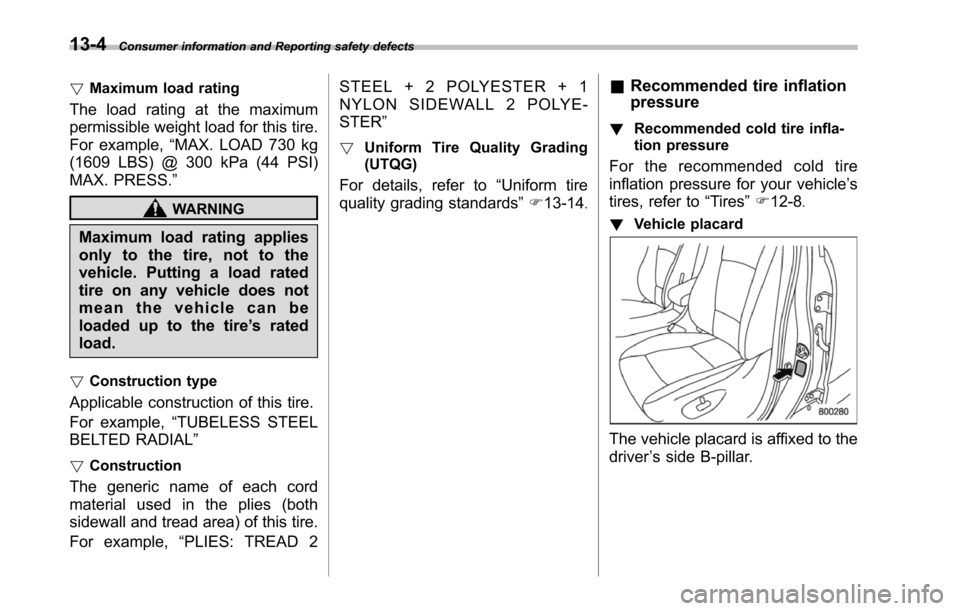
13-4Consumer information and Reporting safety defects
!Maximum load rating
The load rating at the maximum
permissible weight load for this tire.
For example,“MAX. LOAD 730 kg
(1609 LBS) @ 300 kPa (44 PSI)
MAX. PRESS.”
WARNING
Maximum load rating applies
only to the tire, not to the
vehicle. Putting a load rated
tire on any vehicle does not
mean the vehicle can be
loaded up to the tire’s rated
load.
!Construction type
Applicable construction of this tire.
For example,“TUBELESS STEEL
BELTED RADIAL”
!Construction
The generic name of each cord
material used in the plies (both
sidewall and tread area) of this tire.
For example,“PLIES: TREAD 2
STEEL + 2 POLYESTER + 1
NYLON SIDEWALL 2 POLYE-
STER”
!Uniform Tire Quality Grading
(UTQG)
For details, refer to“Uniform tire
quality grading standards”F13-14.
&Recommended tire inflation
pressure
!Recommended cold tire infla-
tion pressure
For the recommended cold tire
inflation pressure for your vehicle’s
tires, refer to“Tires”F12-8.
!Vehicle placard
The vehicle placard is affixed to the
driver’s side B-pillar.